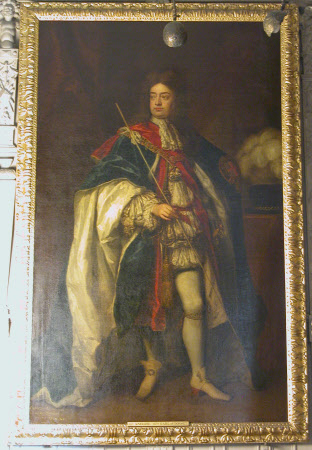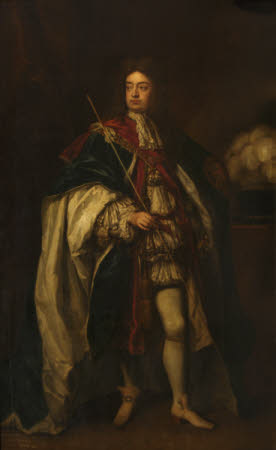Charles Sackville, 6th Earl of Dorset and 1st Earl of Middlesex (1638-1706)
Sir Godfrey Kneller (Lübeck 1646 - London 1723)
Category
Art / Oil paintings
Date
1694 (signed and dated)
Materials
Oil on canvas
Measurements
2388 x 1499 mm (94 x 59 in)
Place of origin
England
Order this imageCollection
Knole, Kent
NT 129909
Summary
Oil painting on canvas, Charles Sackville, 6th Earl of Dorset and 1st Earl of Middlesex (1638-1706) by Sir Godfrey Kneller (Lübeck 1646/9 - London 1723), signed , in black, 28 ins. from bottom of left hand side [according to Phillips, II. 418; not visible in the absence of a bright light]: Godfrey Kneller faciebat 1694 [why no ‘eques’?]. A full-length portrait, turned slightly to the right, head turned to the left, gazing to the left, holding the Lord Chamberlain's wand in his right hand, and wearing coronation robes, his hat is on a table on the right.
Full description
Born during the Civil War, possibly at Copt Hall, as the eldest surviving son of Richard, 5th Earl of Dorset, and his wife, Lady Frances Cranfield, daughter of the 1st Earl of Middlesex, Charles travelled in Europe with his younger brother Edward from December 1658 to 1660, and succeeded his father in 1677, having already through his mother inherited the estates of the last Earl of Middlesex in 1674, and, having had the latter’s titles conferred on him in 1675. Neither proved sufficient to satisfy his expenses. He was, as described by Pepys and Macaulay, a notorious libertine, but he was a poet and a patron of men of letters such as Dryden, Prior and Congreve, and most of the portraits in the room at Knole known at the ‘Poet’s Parlour’ were brought together by him. He was also responsible for accumulating the silver furniture at Knole, which is today such a feature of the house. He was M.P. for East Grinstead, as Lord Buckhurst, from 1661-1675. Although wielding great influence at the Court of Charles II, one of whose Gentlemen of the Bedchamber he was from 1670 to 1685, he fell out of favour under James II and backed the Revolution, so that his public appointments were the result of his support for William III, who appointed him Privy Councillor in 1689, Keeper of Greenwich Palace from 1689 to 1697, Lord Chamberlain of the Household from 1689 to 1697, made him Knight of the Garter in 1692, and for whom he thrice acted as one of the regents during the King’s absences in the Netherlands. By his first wife, Mary Bagot (1645 – 1679), widow of the 1st Earl of Falmouth, whom he married in 1674, he had no children. By his second wife, Mary, daughter of James Compton, 3rd Earl of Northampton, whom he married in 1685, but who died in 1691, he was the father of the 7th Earl, later 1st Duke, of Dorset, and of Mary (1689-1705; m.1702), first wife of Henry, 2nd Duke of Beaufort. More celebrated than either marriage was his liason in 1667-8 with Nell Gwyn, who called him her ‘Charles the first’, and whom – to Pepys’s great disappointment – he persuaded to quit the stage. By Michaelmas 1668, she had become the mistress of Charles the Second, and he was sent on a “sleeveless errand” (Dryden) to Louis XIV. After his liason with her, and both before and after his first marriage, he had two illegitimate daughters by Philippa Waldegrave: Mary (1673-1703, who m. i) Lionel, 3rd Earl of Orrery, and ii) Richard Viscount Shannon; see her portrait by Kneller, KNO/P/145) and Katherine (1675-1690), and possibly a son, William; and later another daughter, Anne, by a woman named Lee. In his old age, sadly, he grew fat and – according to Swift – extremely dull. This may have been the result of premature senility, for he also fell into the clutches of a third wife, his housekeeper ‘Anne Roche’, “a woman … of very obscure connections”, whom he married in 1704 and “who held him in a sort of captivity at Bath, where he expired” (Wraxall’s Memoirs, 1884, vol.III, p.136) [but see Congreve’s account of him then, below]. His early misdemeanours, which included the murder or manslaughter of a night-watchman, and, with Sir Charles Sedley and Sir Thomas Ogle, causing a riot by exposing themselves on the balcony of an inn-cum-brothel, appear to have been rapidly forgotten and forgiven by some – but not all. John Macky, for instance, in his Characters of the Court of Britain (1733) – not Bishop Burnet, as stated in the Complete Peerage, vol.IV, pp.426-27, note (h) – though contradicted by Jonathan Swift’s marginalia on his own copy of this (in square brackets here), wrote that he: “Was esteemed one of the finest Gentlemen in England, in the Reign of King Charles the Second; of great Learning [‘small or none’], extremely witty, and hath been the Author of some of the finest Poems in the English Language, especially Satire. The Mecaenas [sic], and Prince of our English Poets, and, as Lord Rochester said of him very justly, was, The best good Man, with the worst natur’d Muse … He is still one of the pleasantest Companions in the World [‘Not of late years, but a very dull one], when he likes his company.” (Swift, Miscellaneous and Autobiographical Pieces, Fragments, and Marginalia, ed. Herbert Davis, Oxford, 1962, p.258; for Macky’s Characters – which Burnet intended to, but did not, incorporate into the History of his Own Time, and which Macky wrote for the Electress Sophia around 1703 – see the facsimile edition of the Memoirs of the Secret Services of John Macky, Esq. ed. By Charles Butler for The Roxburghe Club, with the Memoirs of the Life of Sir John Clerk, 1895, pp.55-56). Horace Walpole – unsurprisingly – was yet more benign, in A Catalogue of the Royal and Noble Authors of England, Scotland and Ireland (ed. Thos. Park, 1806, vol.IV, pp.13-15): “He was the finest gentleman in the voluptuous court of Charles the second, and in the gloomy one of King William. He had as much wit as his first master, or his contemporaries Buckingham and Rochester, without the royal want of feeling, the duke’s want of principles, or the earl’s want of thought. The latter said with astonishment, “That he did not know how it was, but lord Dorset might do anything and yet was never to blame.” It was not that he was free from the failings of humanity, but he had the tenderness of it too, which made everybody excuse whom everybody loved … When he was dying, Congreve, who had been to visit him, being asked how he had left him, replied, “Faith, he slabbers more wit than other people have in their best health.” Even the new Oxford DNB, less censorious than the old, stresses his hospitality, generous patronage, and kind-heartedness, and says that: “His courtly and libertine lyrics are thoroughly deserving of the praise given to them by Dryden and Pope.” Without citing its source (actually The Historical and the Posthumous Memoirs of Sir Nathaniel William Wraxall, ed. H.W. Wheatley, 1884, vol.III, p.136), it also quotes a charming example of his chivalry – the episode of Queen Elizabeth and Sir Walter Raleigh’s cloak in parvo, as it were: at the Revolution, Dorset and his wife’s uncle, Henry Compton, the Whig Bishop of London, were entrusted with the task of assisting Princess Anne to escape from Whitehall. During her flight from the palace, one of her shoes stuck in the mud, which Dorset immediately replaced with one of his white gloves. His munificence is best remembered by the anecdote of a party at Knole, at which it was decided that each guest, and the host, should write an impromtu, and that Dryden should be called upon to decide which was most apt. Having studied them all, he declared that none could surpass their host’s, which went: “I promise to pay Mr. John Dryden or order five hundred pounds on demand.”
Provenance
In the 1706 inventory as “the Earl of Dorsett”, one of a pair of whole-lengths (with no.237) amongst the ten whole-lengths in “the great Dining Roome” [=Ballroom]; 1799 inv.: “Charles Earl of Dorset Kneller”, in the Ball Room; 1828 inv., ibid; (No. 46); on loan from the Trustees of the Sackville Estate
Credit line
Knole, The Sackville Collection
Makers and roles
Sir Godfrey Kneller (Lübeck 1646 - London 1723), publisher
References
Ingamells, 2009: John Ingamells, Later Stuart Portraits 1685-1714, National Portrait Gallery, London, 2009, p.76

